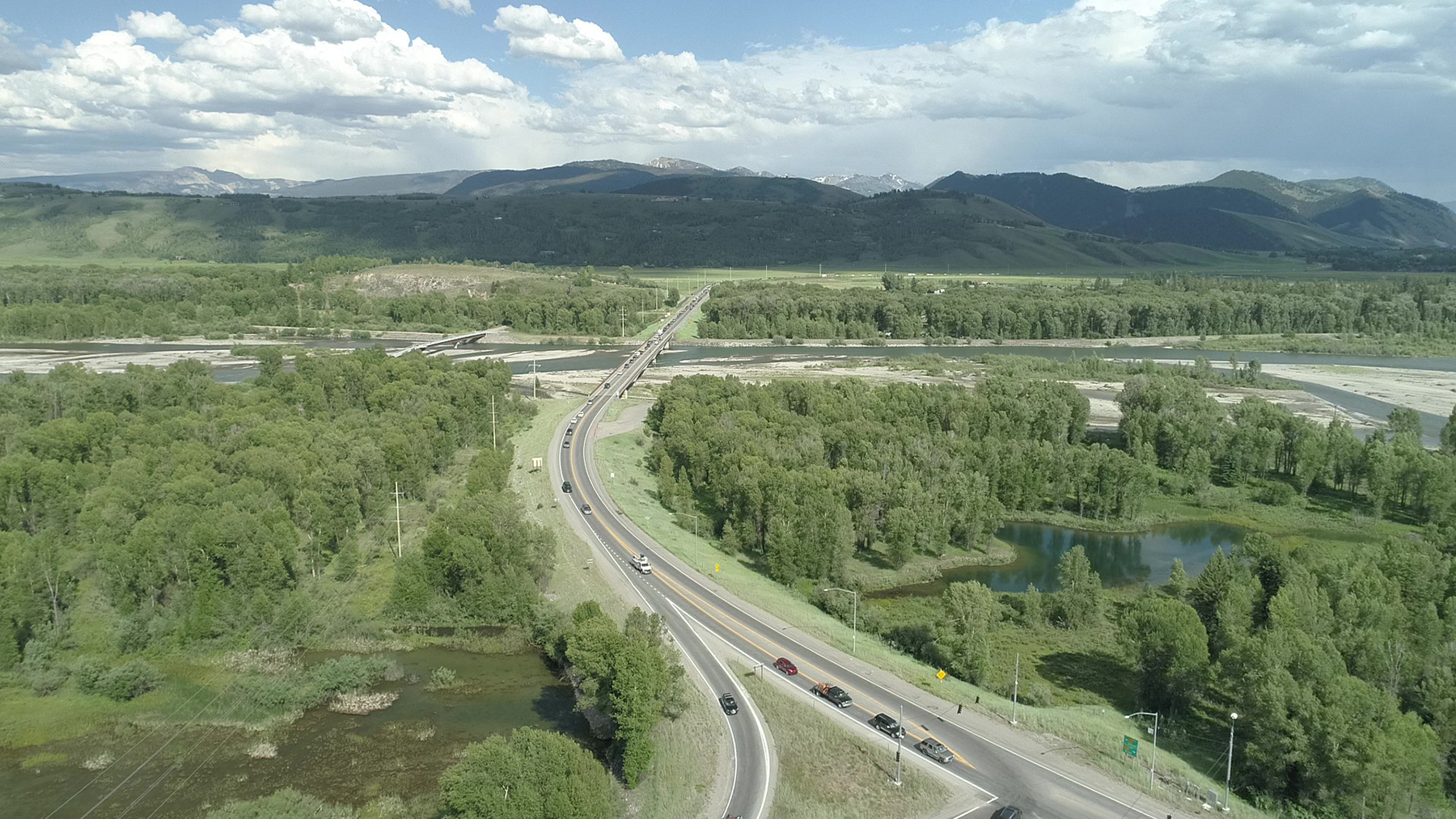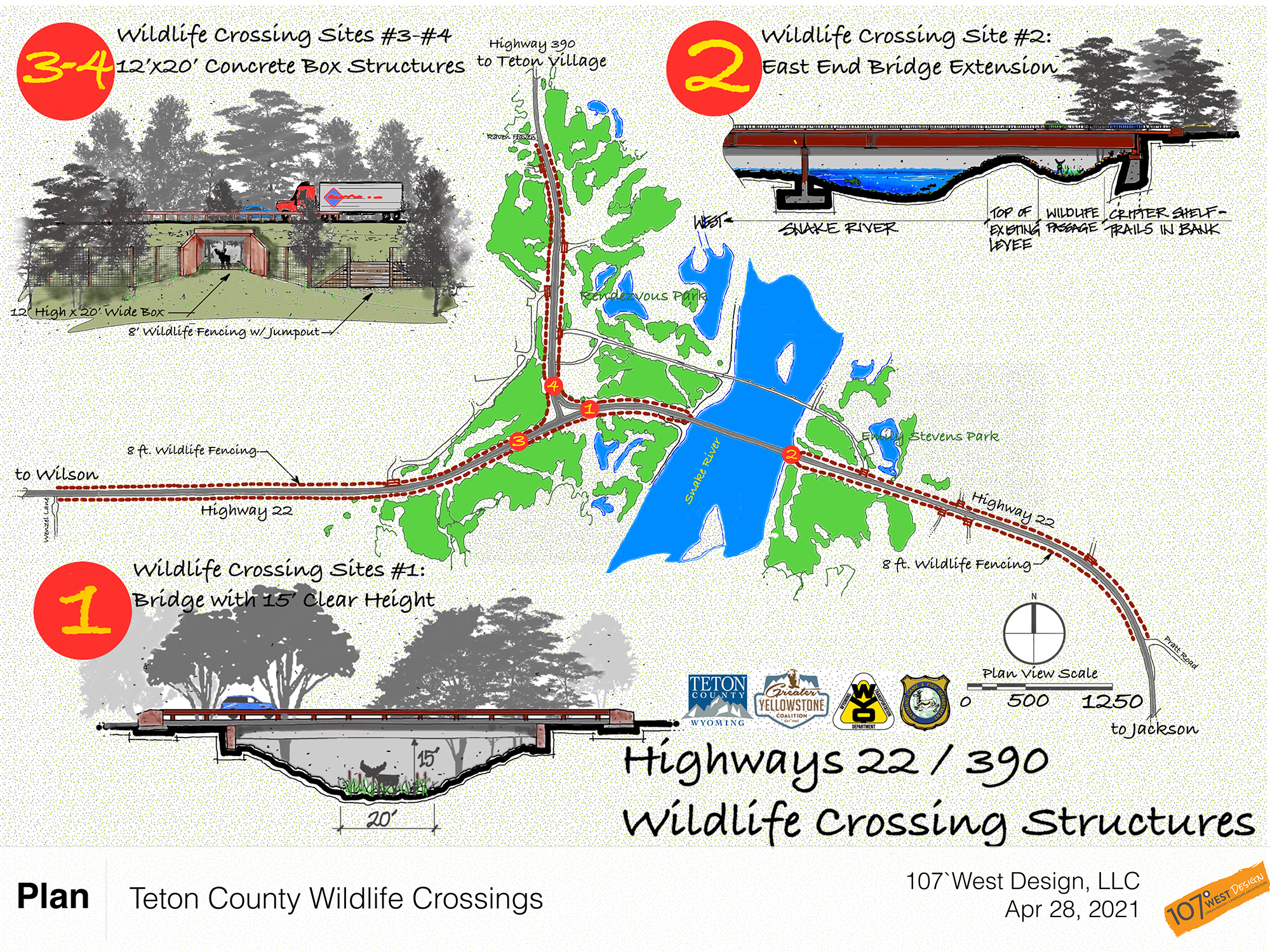By Jay Landers
A planned bridge replacement project near Jackson, Wyoming, has been designed to accommodate the needs of human — and wildlife — travelers. Area collisions between motorists and animals, particularly moose, will be reduced with the construction of multiple wildlife crossings. At the same time, the $28 million project will increase public safety and reduce traffic congestion by replacing an aging bridge over the Snake River and improving a nearby highway intersection that is a major source of delays.
Key highways
Approximately 17.5 mi long, Wyoming Highway 22 extends west from the popular tourist destination of Jackson to the nearby town of Wilson and on to the Idaho border. The primary route between these destinations, WYO 22 has an average daily traffic volume of more than 15,000 vehicles.
And approximately 5 mi west of Jackson, WYO 22 crosses the Snake River. Since 1960, an 884.5 ft long steel girder bridge with two lanes of traffic has stood at the site. In 2014, the aging bridge was “deemed structurally deficient and fracture critical, meaning that any significant damage could render it unusable,” says Peter Stinchcomb, P.E., the construction engineer for the Wyoming Department of Transportation’s District 3, which encompasses the southwest section of the state. “It is also past its life span and in poor condition.”
Just west of the Snake River, in Wilson, WYO 22 connects with the south end of WYO 390. Roughly 15 mi long, WYO 390 runs north to Teton Village — the home of the famed Jackson Hole Mountain Resort — and on to the Grand Teton National Park, a major tourist destination. However, tourists are not the only ones using the two Wyoming highways. Because of the high cost of living in Jackson, most of the workers employed in the town commute to their jobs, often using one or both roadways.
‘Collision area for moose’
As the only local connection between Jackson and the nearby towns west of the Snake River, the existing bridge over the waterway is a “key crossing point for Teton County,” Stinchcomb says. The bridge also serves as a “critical route for emergency responders in the area,” he notes. Meanwhile, the location of the bridge is a popular spot for public access to various forms of recreation, including river rafting, bicycling, and pedestrian use. “There are many competing interests in the area that add complex factors to transportation decisions,” Stinchcomb says.

The area in and around the Snake River Bridge and the intersection of WYO 22 and WYO 390 also provides habitat for a wide variety of wildlife, including moose, deer, and elk.
“Wildlife is highly prioritized in this area, as it affects tourism and is a part of the cultural aesthetic of the valley,” says Stephanie Harsha, a WYDOT public relations specialist. “This particular area is very visible to the public, and tourists will often come to see moose and elk. There are moose in this area year-round, and (they) have been recorded crossing (WYO 22) up to 150 times a year. The wildlife in the area also tend to create ‘wildlife jams,’ where traffic is slowed or stopped to view or wait for wildlife.”
“Although this area is not regarded as a hot spot for the frequency of vehicle collisions from a statewide perspective, it is a collision area for moose in particular,” Harsha says.
Protecting wildlife
Like the original span, the 980 ft long replacement bridge will consist of a steel girder structure. The new crossing will be wide enough to accommodate four 12 ft lanes with 8 ft shoulders on either side. Key considerations during the project design included facilitating “better traffic flow to alleviate congestion, wildlife permeability to allow safe crossing options for the wildlife in the area, pedestrian use, and capacity improvement,” Stinchcomb says.

To accommodate wildlife, the project calls for adding four wildlife crossing sites: one beneath the new Snake River Bridge and three beneath the roadways near the intersection of WYO 22 and WYO 390.
The new Snake River Bridge will be longer than the bridge it is replacing so that a wildlife passageway can be added between the levee along the east bank of the waterway and the east end of the structure. To the west, a new overpass will be constructed along a short section of WYO 22, near the intersection with WYO 390, so that a wildlife passageway having a clear height of 15 ft can be created underneath.
The other two passageways — one to be on WYO 22 west of the intersection and one on WYO 390 north of the intersection — will consist of 12 ft by 20 ft concrete box structures constructed beneath the roadways.
“We hope to see many different types of animals using the crossings, from big game such as moose, deer, and elk to smaller game like fox, mountain lions, and raccoons,” Harsha says.
To dissuade animals from entering the roadways, double cattle guards will be used at vehicle approaches and 8 ft tall wildlife fencing will be constructed along the highways. Designed to direct animals to the wildlife crossings, the fencing will also include lower heights in certain locations to provide “jump outs” for animals that still manage to enter the roadway areas that have been fenced off.
In April, the Federal Highway Administration within the U.S. Department of Transportation notified WYDOT that the project had won a 2022 Environmental Excellence Award in the category of Ecosystems, Habitat, and Wildlife. WYDOT will accept the award in mid-July.
Intersection improvements
As for the improvements to the intersection of WYO 22 and WYO 390, the project calls for implementing a so-called Florida T intersection. Designed to increase traffic flows and reduce congestion, the Florida T intersection will include a separate lane for eastbound traffic on WYO 22 to bypass the intersection. A median will divide this lane from the rest of the intersection.
“This particular intersection allows for free flow of eastbound traffic on WYO 22, which helps prevent traffic backup into the community of Wilson,” Harsha says. “This free flow also allows the other legs of traffic more signal time, eliminating queues of traffic more quickly.”
Final plans for the project were issued by WYDOT in late January, Harsha says. “The general plans were done by the WYDOT design team in collaboration with (the design firm HDR) and with input from our public involvement stakeholder group,” she notes. A 2014 Planning and Environmental Linkages Study for the project was prepared by Jacobs, which also hosted a virtual public meeting and coordinated public involvement needs regarding the project.
Construction on the project is expected to begin late this fall or in spring 2023 and last until summer or fall 2025. Construction phasing will entail building half of the new Snake River Bridge while traffic continues to use the existing structure. Once the new half is complete, traffic will be routed onto it, the existing span removed, and the other half of the new bridge constructed.
Teton County is funding two of the wildlife crossings, which are estimated to cost approximately $3 million, while the rest of the project funding is provided by the federal government.
The funding information in this article was updated with additional information.



